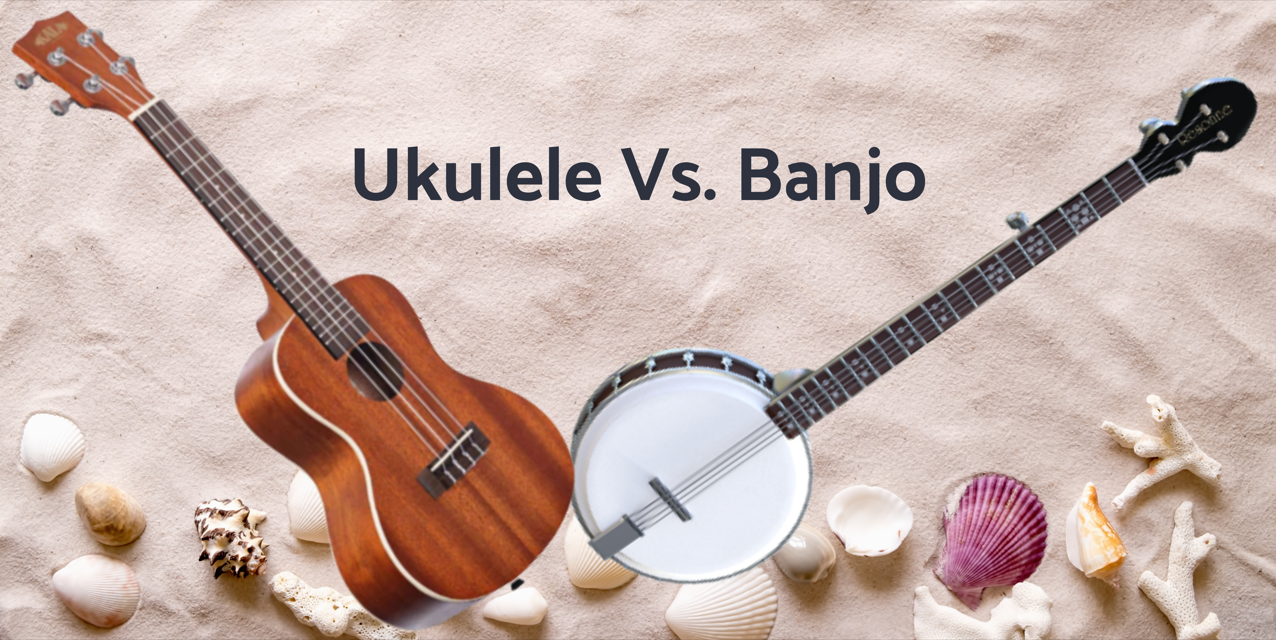Banjo vs. Ukulele: Which One Should You Choose?

Are you in the midst of a musical dilemma? Maybe you’re struggling to choose between two unique instruments, such as the ukulele and banjo.
No need to fret away any longer!
We’ll delve into the deep-rooted histories behind each instrument, examine their specific functions and strengths, and compare their sound quality and portability capabilities—all with wit, humour, and maybe a few puns sprinkled on top.
Wondering what the difference is between a banjo and a ukulele?
Let's explore each one so that you can make an informed decision for your next jam session. In this blog post, we’ll explore both of these seemingly disparate instruments to discover which one would best suit your needs. it's time to decide which fretful fretboard is right for you! Check out our guide to help you choose which instrument is right for you.
History: The Origins of the Ukulele and Banjo
Ukulele
Ukuleles have been serenading us with their sweet tunes since the 1800s! Although they look like Hawaiian instruments today, they're actually Portuguese in origin.
With only four strings and a short neck, the ukulele may be small in size - but it packs an incredible punch! With its vibrant notes and captivating rhythms, you can find so much musical magic hidden within this pint-sized instrument.
Who introduced the first ukulele in Hawaii?
The ukulele has a fascinating history! It was first brought to Hawaii in 1879 by Joao Fernandez, a Portuguese immigrant. Who needs a welcome party when you can make your own? This Portuguese immigrant certainly knew how to spice up their arrival - jumping off the boat with branguinha in hand, singing an upbeat tune, and strumming away! Talk about making waves.

The Hawaiians were so enthralled by him that they gave it its name, "ukulele," which translates to “jumping flea"—quite fitting for such an amazingly agile musical tool! Even King Kalakaua himself learned how to play this new craze before long. By 1900, you could hear the tune of the 'oo-ku-lay lay' everywhere across these islands.
Who created the first ukulele?
Three immigrants, Manuel Nunes, José do Espírito Santo and Augusto Dias, were instrumental in creating the first-ever ukuleles. Hailing from Madeira Island as cabinet makers, they took their woodworking expertise to Hawaii's lush coastline with a vision of crafting an instrument unlike any other—one that would enchant music lovers around the globe. They are widely recognized as being responsible for bringing the beloved ukulele to life.
Banjo
The banjo has a long and rich history, with roots reaching back to West African traditions. Slaves in the United States were some of the earliest musicians to play the banjo, and they used an instrument known as a gourd banjo. This unique version featured a body made out of dried gourds with an animal skin-covered head that could be strummed either with bare hands or drumsticks.
Over time, this primitive design morphed into our modern-day take on the iconic stringed instrument—one composed of wooden bodies, traditional frets across its long neck, and resonant strings held taut by adjustable drumskins crafted from animal skins.
By the 19th century, this unique instrument had undergone an evolutionary process in the United States. Slaves from the African continent and whites from rural areas combined elements from their musical backgrounds, including Africa, Europe, and Native America, to create what we know today as the banjo.
Since then, the banjo has gained notoriety throughout America as a beloved instrument of traditional folk and bluegrass music. It first rose to prominence through professionals known as minstrel performers—singers and comedians who sought out audiences with their comedic skits paired with masterful tunes on the banjo.
Its popularity was also propagated by African American slaves using it for both spiritual gatherings and engaging dances alike.
From a humble beginning, the banjo quickly became an integral part of American music. Over time, its popularity inspired different techniques and genres, such as bluegrass, old-timey string band songs, classical pieces, and even jazz!
Today, this beloved instrument continues to entertain players and audiences around the world, making sure that it remains firmly embedded within our musical culture for generations to come.

What is a banjo made of?
The banjo is a beloved instrument with an interesting construction. Its modern form consists of a pot-like body, usually crafted from wood or metal depending on its age, and a head that's similar to what you'd find on drums—but it wasn't always like this! Many vintage models featured animal skin heads, which have since been replaced by more advanced synthetic materials in recent years.
The banjo's popularity has led to the creation of high-breed instruments like the banjolele. Banjolele offers a unique, bright sound that's similar to the banjo but more compact and lightweight. Plus, if you already play the ukulele, learning how to strum this instrument should be an easily adaptable skill, as it is tuned the same way!
Ukulele vs. banjo differences
Music lovers often debate the differences between banjos and ukuleles. While both instruments bring a unique quality to any jam session, there are distinct variations that set them apart, from their strings and shapes to the sound they make. For starters, while most modern-day banjos have five strings, classic ukuleles typically come with four, making for an interesting musical contrast!
There's also a difference in shape: banjos tend toward roundness, whereas ukuleles have more of an asymmetrical look. Last but not least is sonic variance; where classical banjo melodies rock out with resonant twangs on higher frets or chords strummed near open Gs, ukulele tunes rely mostly on richer mid-tones played across all notes at once. No matter which instrument you choose, though, both guarantee sweet music!
The banjo and ukulele offer contrasting styles of play, with various advantages to each. When selecting between the two instruments, it's essential to weigh up their differences, including size, sound production complexity, and strings.
Types Of Strings Used
The decision to play a banjo or ukulele can be tricky; however, strings could be the deciding factor in your choice. Banjos have metal strings that require an extra level of strength and determination to master effectively due to their fast-paced style. On the other hand, nylon-stringed ukuleles are much easier on the fingers, giving players more flexibility and control over chords, making them a definite winner for those just starting!
How They Sound
When choosing between the ukulele and banjo, it all comes down to your preference in sound and music style. Banjos provide a trademark soulful twang that works for blues, bluegrass, and folk, whereas rich, high-pitched tones from ukuleles are perfect for genres like pop or island-themed melodies such as Hawaiian or reggae. But if you're looking for more variety with your instrument of choice, then the banjo offers much greater musical flexibility since it's been used across rock, jazz, and other styles too!
Overall Musical Appeal Of The Instrument
When debating the merits of ukuleles versus banjos, it's important to consider not just their technical capabilities but also public perception. While its popularity has grown in recent years and many musicians value it as a legitimate instrument, the ukulele still carries with it an association of fun and frivolity, making some serious music lovers more likely to opt for the heftier sound found in playing the banjo.
With its increasing popularity, the ukulele has surpassed any notion of being a "toy guitar," making it indisputably accepted as an instrument. Whether you are looking for fun or to create complex music pieces, both instruments have unique characteristics that can help shape your playing style and bring out the best in each one!
Price
The ukulele is the obvious choice for portability, weight, and budget-conscious buyers. Featuring a manageable size and lightweight design, it can go anywhere you go with ease—plus, it won't break the bank! Banjos, on the other hand, offer great power but come at a premium price tag due to their heavier build, so if comfort isn’t your main concern, then consider this option instead.
Amount of difficulty in playing
The ukulele is the perfect jumping-off point for guitarists looking to explore other stringed instruments. An understanding of three simple chords can be enough to achieve an impressive basic level in as little as two hours, making it easily accessible and a great way to build confidence.
The banjo has many more complexities that pose greater challenges: intricate parts, complicated strumming patterns, and superior coordination are essential requirements if you're hoping to make music with this instrument!
Choosing Between The Banjo And The Ukulele
So, having come to the end of this post on stringed instruments, we hope we’ve been able to help you narrow your options. Both banjos and ukuleles are great choices, especially for curious newbies. Don't let the strings scare you! When you take up a lesson in either of these, you’re sure to get better with practice and clean technique.
Now comes the decision: which one fits your personality best? The ukulele is cute and portable, while the banjo makes awesome bluegrass music. Whichever way you go, don't let it be a regretful moment! We'll leave the ultimate call up to you; tell us which instrument you prefer. Let us know in the comments below and weigh in on why you prefer that instrument over the other!
 Lifetime Warranty
Lifetime Warranty  60 Day Returns Policy
60 Day Returns Policy 1-2 Day Delivery
1-2 Day Delivery 































Leave a comment